Construction Project: Detailed Scope, Cost, and Risk Management Report
VerifiedAdded on 2022/08/21
|43
|12658
|15
Report
AI Summary
This report comprehensively examines construction project management, focusing on scope, cost, and risk management. It begins with an introduction to project management principles, emphasizing the importance of critical success factors and the phases of a project. A detailed literature review explores project cost management, scope management, and risk management, drawing on various scholarly articles and studies. The report then presents three case studies: a lecture project, the Sydney Opera House, and the exploitation of foreign workers in Australia, analyzing each in terms of their project management challenges and outcomes. Following the case studies, the report identifies challenges in cost, scope, and risk management, and proposes corresponding strategies to overcome these issues. The report concludes with recommendations for effective project management and a summary of key findings, providing a valuable resource for students and professionals alike. The report also highlights the importance of data-driven decision-making and the use of appropriate tools and techniques to ensure project success.
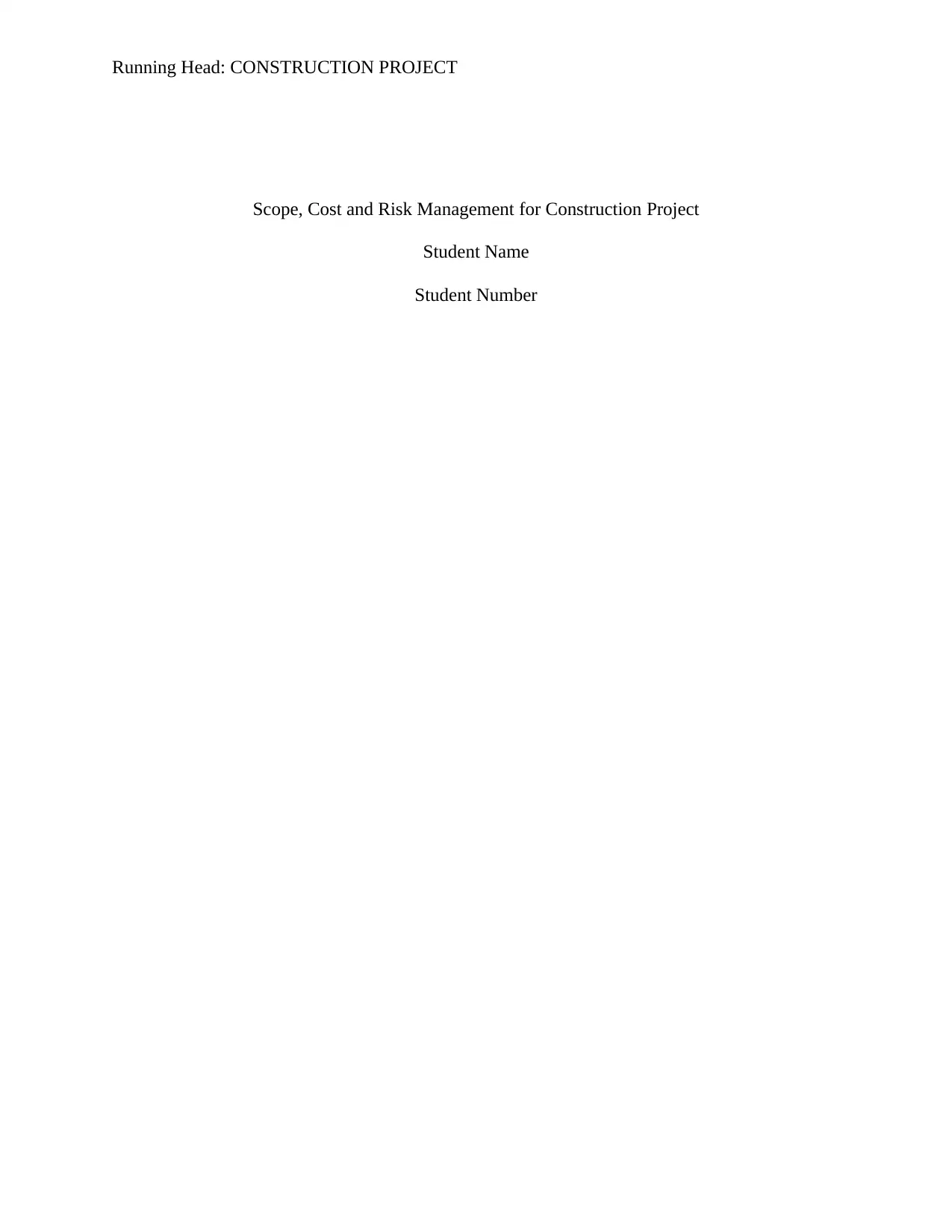
Running Head: CONSTRUCTION PROJECT
Scope, Cost and Risk Management for Construction Project
Student Name
Student Number
Scope, Cost and Risk Management for Construction Project
Student Name
Student Number
Paraphrase This Document
Need a fresh take? Get an instant paraphrase of this document with our AI Paraphraser
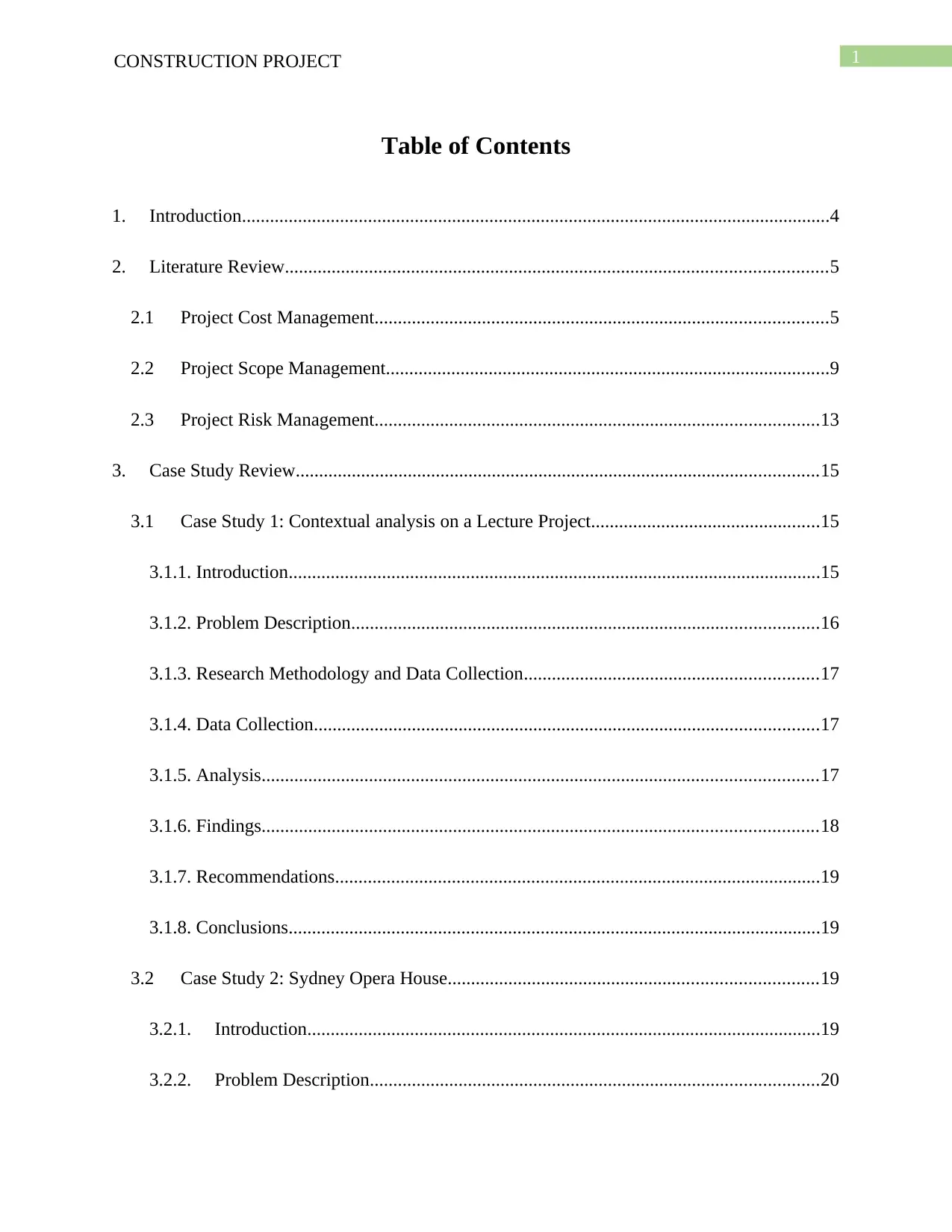
1CONSTRUCTION PROJECT
Table of Contents
1. Introduction..............................................................................................................................4
2. Literature Review....................................................................................................................5
2.1 Project Cost Management.................................................................................................5
2.2 Project Scope Management...............................................................................................9
2.3 Project Risk Management...............................................................................................13
3. Case Study Review................................................................................................................15
3.1 Case Study 1: Contextual analysis on a Lecture Project.................................................15
3.1.1. Introduction..................................................................................................................15
3.1.2. Problem Description....................................................................................................16
3.1.3. Research Methodology and Data Collection...............................................................17
3.1.4. Data Collection............................................................................................................17
3.1.5. Analysis.......................................................................................................................17
3.1.6. Findings.......................................................................................................................18
3.1.7. Recommendations........................................................................................................19
3.1.8. Conclusions..................................................................................................................19
3.2 Case Study 2: Sydney Opera House...............................................................................19
3.2.1. Introduction..............................................................................................................19
3.2.2. Problem Description................................................................................................20
Table of Contents
1. Introduction..............................................................................................................................4
2. Literature Review....................................................................................................................5
2.1 Project Cost Management.................................................................................................5
2.2 Project Scope Management...............................................................................................9
2.3 Project Risk Management...............................................................................................13
3. Case Study Review................................................................................................................15
3.1 Case Study 1: Contextual analysis on a Lecture Project.................................................15
3.1.1. Introduction..................................................................................................................15
3.1.2. Problem Description....................................................................................................16
3.1.3. Research Methodology and Data Collection...............................................................17
3.1.4. Data Collection............................................................................................................17
3.1.5. Analysis.......................................................................................................................17
3.1.6. Findings.......................................................................................................................18
3.1.7. Recommendations........................................................................................................19
3.1.8. Conclusions..................................................................................................................19
3.2 Case Study 2: Sydney Opera House...............................................................................19
3.2.1. Introduction..............................................................................................................19
3.2.2. Problem Description................................................................................................20
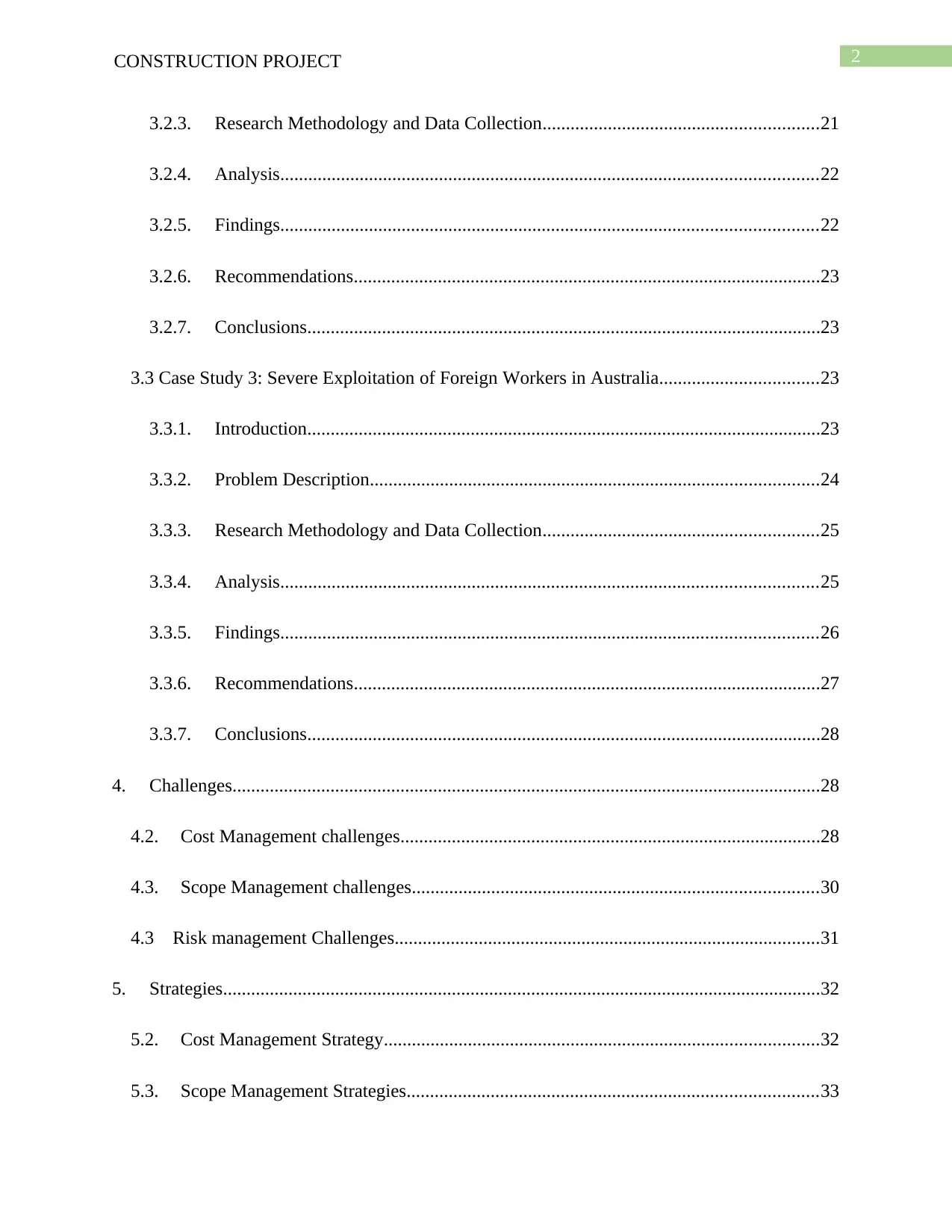
2CONSTRUCTION PROJECT
3.2.3. Research Methodology and Data Collection...........................................................21
3.2.4. Analysis...................................................................................................................22
3.2.5. Findings...................................................................................................................22
3.2.6. Recommendations....................................................................................................23
3.2.7. Conclusions..............................................................................................................23
3.3 Case Study 3: Severe Exploitation of Foreign Workers in Australia..................................23
3.3.1. Introduction..............................................................................................................23
3.3.2. Problem Description................................................................................................24
3.3.3. Research Methodology and Data Collection...........................................................25
3.3.4. Analysis...................................................................................................................25
3.3.5. Findings...................................................................................................................26
3.3.6. Recommendations....................................................................................................27
3.3.7. Conclusions..............................................................................................................28
4. Challenges..............................................................................................................................28
4.2. Cost Management challenges..........................................................................................28
4.3. Scope Management challenges.......................................................................................30
4.3 Risk management Challenges...........................................................................................31
5. Strategies................................................................................................................................32
5.2. Cost Management Strategy.............................................................................................32
5.3. Scope Management Strategies........................................................................................33
3.2.3. Research Methodology and Data Collection...........................................................21
3.2.4. Analysis...................................................................................................................22
3.2.5. Findings...................................................................................................................22
3.2.6. Recommendations....................................................................................................23
3.2.7. Conclusions..............................................................................................................23
3.3 Case Study 3: Severe Exploitation of Foreign Workers in Australia..................................23
3.3.1. Introduction..............................................................................................................23
3.3.2. Problem Description................................................................................................24
3.3.3. Research Methodology and Data Collection...........................................................25
3.3.4. Analysis...................................................................................................................25
3.3.5. Findings...................................................................................................................26
3.3.6. Recommendations....................................................................................................27
3.3.7. Conclusions..............................................................................................................28
4. Challenges..............................................................................................................................28
4.2. Cost Management challenges..........................................................................................28
4.3. Scope Management challenges.......................................................................................30
4.3 Risk management Challenges...........................................................................................31
5. Strategies................................................................................................................................32
5.2. Cost Management Strategy.............................................................................................32
5.3. Scope Management Strategies........................................................................................33
⊘ This is a preview!⊘
Do you want full access?
Subscribe today to unlock all pages.

Trusted by 1+ million students worldwide
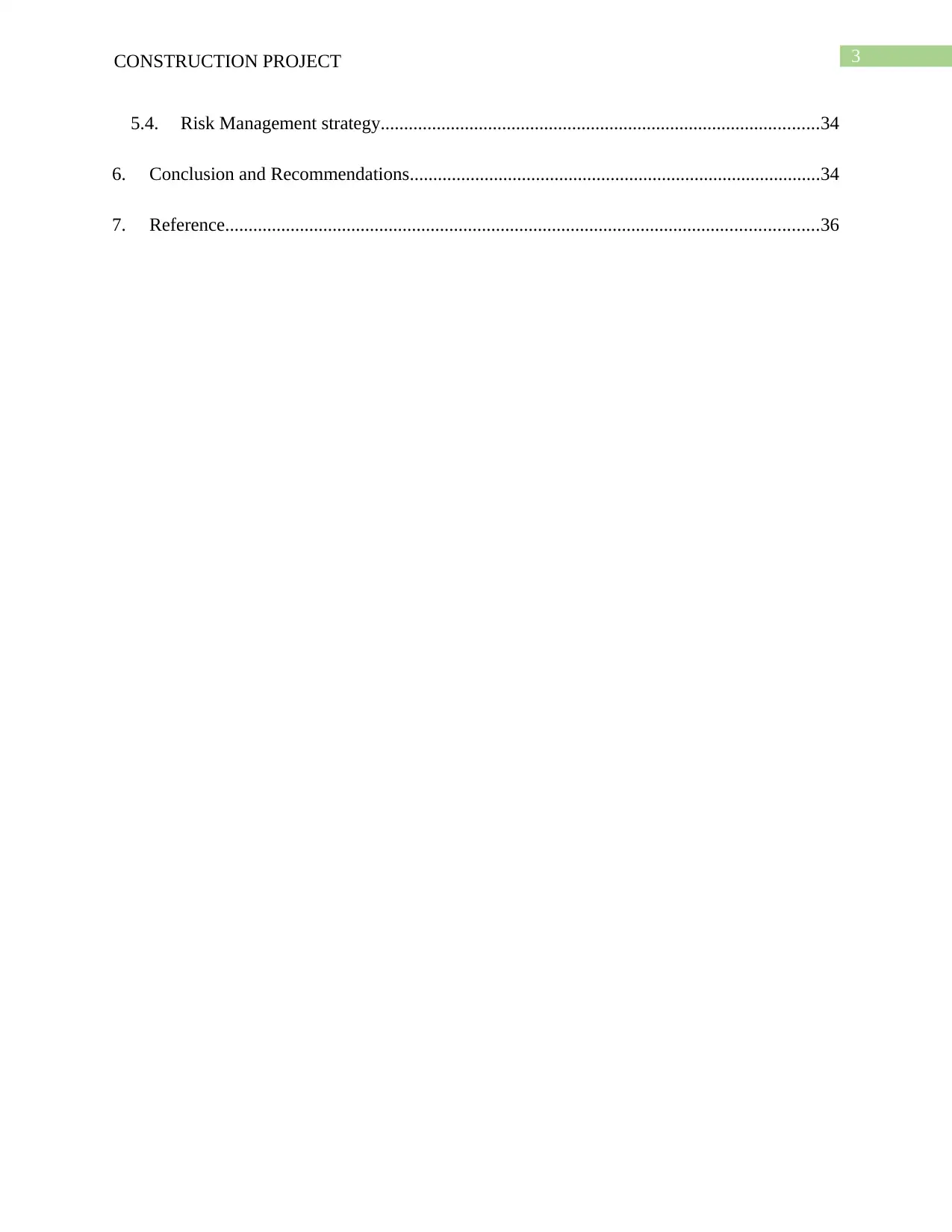
3CONSTRUCTION PROJECT
5.4. Risk Management strategy..............................................................................................34
6. Conclusion and Recommendations........................................................................................34
7. Reference...............................................................................................................................36
5.4. Risk Management strategy..............................................................................................34
6. Conclusion and Recommendations........................................................................................34
7. Reference...............................................................................................................................36
Paraphrase This Document
Need a fresh take? Get an instant paraphrase of this document with our AI Paraphraser
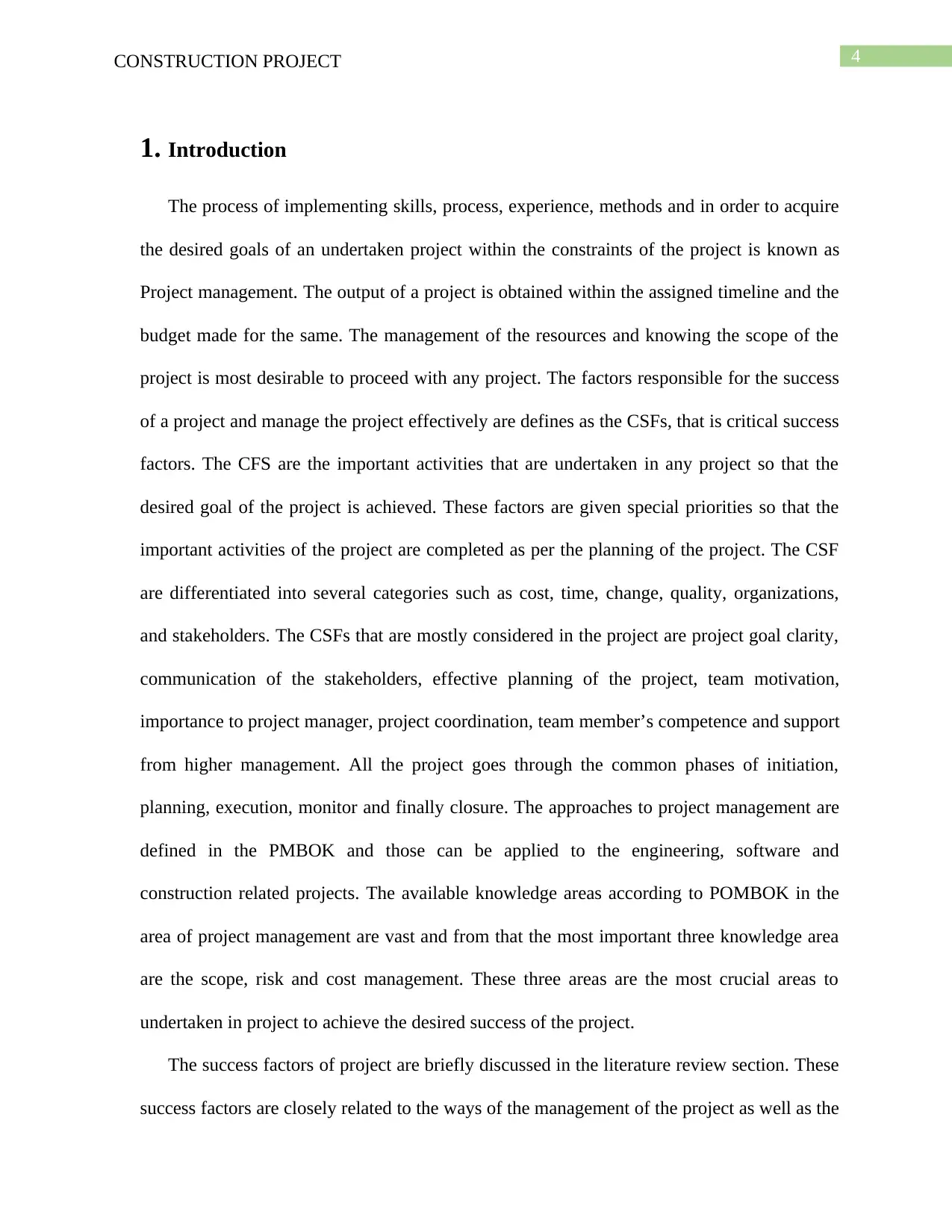
4CONSTRUCTION PROJECT
1. Introduction
The process of implementing skills, process, experience, methods and in order to acquire
the desired goals of an undertaken project within the constraints of the project is known as
Project management. The output of a project is obtained within the assigned timeline and the
budget made for the same. The management of the resources and knowing the scope of the
project is most desirable to proceed with any project. The factors responsible for the success
of a project and manage the project effectively are defines as the CSFs, that is critical success
factors. The CFS are the important activities that are undertaken in any project so that the
desired goal of the project is achieved. These factors are given special priorities so that the
important activities of the project are completed as per the planning of the project. The CSF
are differentiated into several categories such as cost, time, change, quality, organizations,
and stakeholders. The CSFs that are mostly considered in the project are project goal clarity,
communication of the stakeholders, effective planning of the project, team motivation,
importance to project manager, project coordination, team member’s competence and support
from higher management. All the project goes through the common phases of initiation,
planning, execution, monitor and finally closure. The approaches to project management are
defined in the PMBOK and those can be applied to the engineering, software and
construction related projects. The available knowledge areas according to POMBOK in the
area of project management are vast and from that the most important three knowledge area
are the scope, risk and cost management. These three areas are the most crucial areas to
undertaken in project to achieve the desired success of the project.
The success factors of project are briefly discussed in the literature review section. These
success factors are closely related to the ways of the management of the project as well as the
1. Introduction
The process of implementing skills, process, experience, methods and in order to acquire
the desired goals of an undertaken project within the constraints of the project is known as
Project management. The output of a project is obtained within the assigned timeline and the
budget made for the same. The management of the resources and knowing the scope of the
project is most desirable to proceed with any project. The factors responsible for the success
of a project and manage the project effectively are defines as the CSFs, that is critical success
factors. The CFS are the important activities that are undertaken in any project so that the
desired goal of the project is achieved. These factors are given special priorities so that the
important activities of the project are completed as per the planning of the project. The CSF
are differentiated into several categories such as cost, time, change, quality, organizations,
and stakeholders. The CSFs that are mostly considered in the project are project goal clarity,
communication of the stakeholders, effective planning of the project, team motivation,
importance to project manager, project coordination, team member’s competence and support
from higher management. All the project goes through the common phases of initiation,
planning, execution, monitor and finally closure. The approaches to project management are
defined in the PMBOK and those can be applied to the engineering, software and
construction related projects. The available knowledge areas according to POMBOK in the
area of project management are vast and from that the most important three knowledge area
are the scope, risk and cost management. These three areas are the most crucial areas to
undertaken in project to achieve the desired success of the project.
The success factors of project are briefly discussed in the literature review section. These
success factors are closely related to the ways of the management of the project as well as the
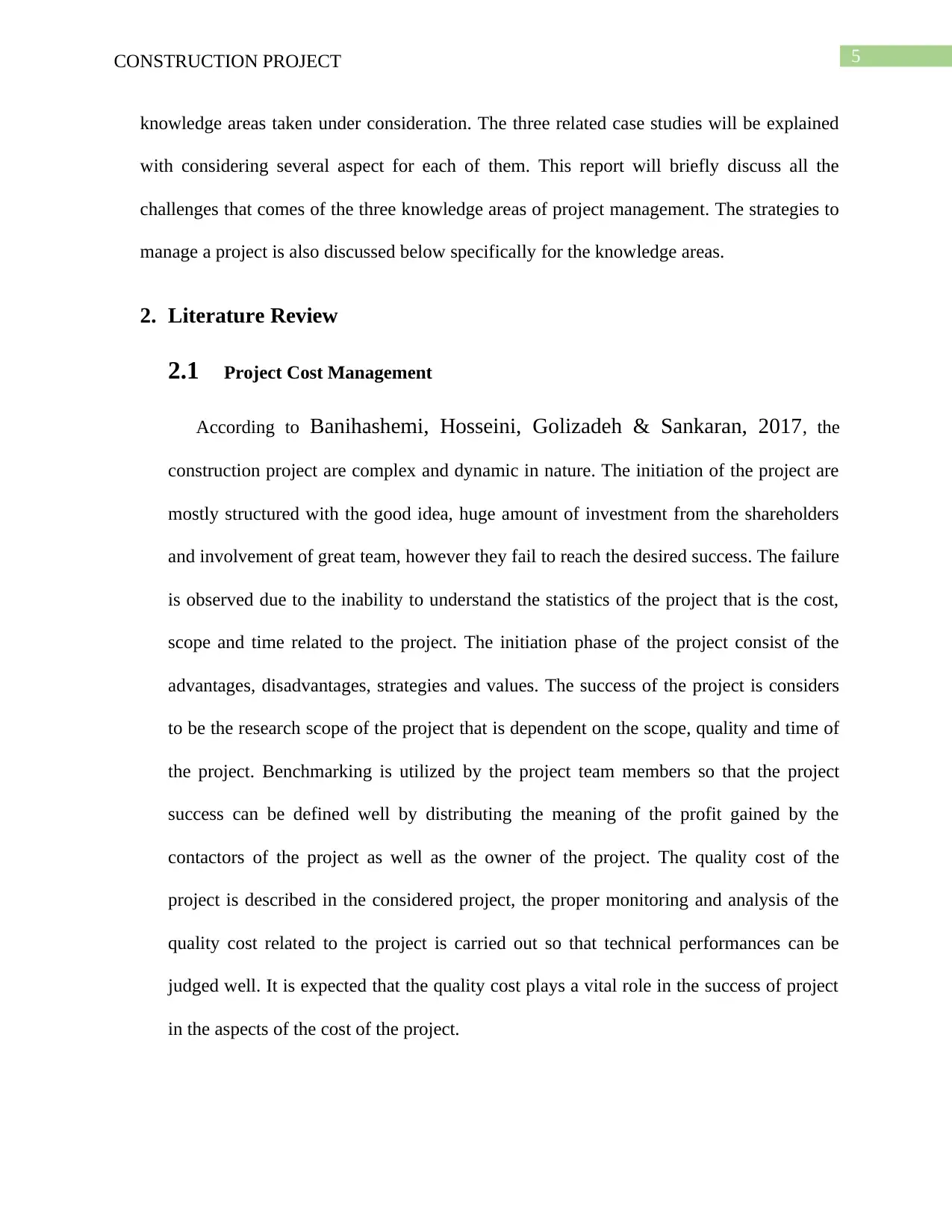
5CONSTRUCTION PROJECT
knowledge areas taken under consideration. The three related case studies will be explained
with considering several aspect for each of them. This report will briefly discuss all the
challenges that comes of the three knowledge areas of project management. The strategies to
manage a project is also discussed below specifically for the knowledge areas.
2. Literature Review
2.1 Project Cost Management
According to Banihashemi, Hosseini, Golizadeh & Sankaran, 2017, the
construction project are complex and dynamic in nature. The initiation of the project are
mostly structured with the good idea, huge amount of investment from the shareholders
and involvement of great team, however they fail to reach the desired success. The failure
is observed due to the inability to understand the statistics of the project that is the cost,
scope and time related to the project. The initiation phase of the project consist of the
advantages, disadvantages, strategies and values. The success of the project is considers
to be the research scope of the project that is dependent on the scope, quality and time of
the project. Benchmarking is utilized by the project team members so that the project
success can be defined well by distributing the meaning of the profit gained by the
contactors of the project as well as the owner of the project. The quality cost of the
project is described in the considered project, the proper monitoring and analysis of the
quality cost related to the project is carried out so that technical performances can be
judged well. It is expected that the quality cost plays a vital role in the success of project
in the aspects of the cost of the project.
knowledge areas taken under consideration. The three related case studies will be explained
with considering several aspect for each of them. This report will briefly discuss all the
challenges that comes of the three knowledge areas of project management. The strategies to
manage a project is also discussed below specifically for the knowledge areas.
2. Literature Review
2.1 Project Cost Management
According to Banihashemi, Hosseini, Golizadeh & Sankaran, 2017, the
construction project are complex and dynamic in nature. The initiation of the project are
mostly structured with the good idea, huge amount of investment from the shareholders
and involvement of great team, however they fail to reach the desired success. The failure
is observed due to the inability to understand the statistics of the project that is the cost,
scope and time related to the project. The initiation phase of the project consist of the
advantages, disadvantages, strategies and values. The success of the project is considers
to be the research scope of the project that is dependent on the scope, quality and time of
the project. Benchmarking is utilized by the project team members so that the project
success can be defined well by distributing the meaning of the profit gained by the
contactors of the project as well as the owner of the project. The quality cost of the
project is described in the considered project, the proper monitoring and analysis of the
quality cost related to the project is carried out so that technical performances can be
judged well. It is expected that the quality cost plays a vital role in the success of project
in the aspects of the cost of the project.
⊘ This is a preview!⊘
Do you want full access?
Subscribe today to unlock all pages.

Trusted by 1+ million students worldwide
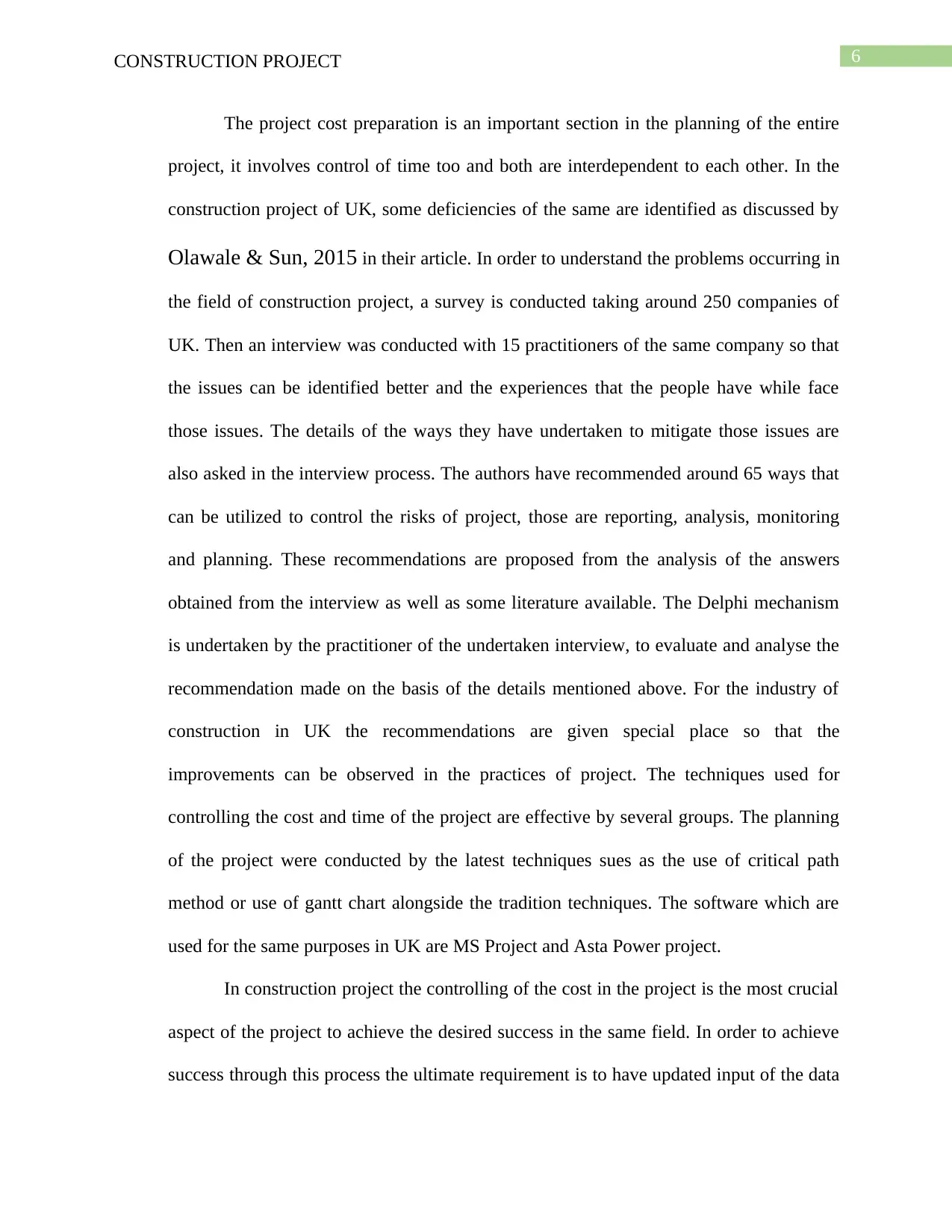
6CONSTRUCTION PROJECT
The project cost preparation is an important section in the planning of the entire
project, it involves control of time too and both are interdependent to each other. In the
construction project of UK, some deficiencies of the same are identified as discussed by
Olawale & Sun, 2015 in their article. In order to understand the problems occurring in
the field of construction project, a survey is conducted taking around 250 companies of
UK. Then an interview was conducted with 15 practitioners of the same company so that
the issues can be identified better and the experiences that the people have while face
those issues. The details of the ways they have undertaken to mitigate those issues are
also asked in the interview process. The authors have recommended around 65 ways that
can be utilized to control the risks of project, those are reporting, analysis, monitoring
and planning. These recommendations are proposed from the analysis of the answers
obtained from the interview as well as some literature available. The Delphi mechanism
is undertaken by the practitioner of the undertaken interview, to evaluate and analyse the
recommendation made on the basis of the details mentioned above. For the industry of
construction in UK the recommendations are given special place so that the
improvements can be observed in the practices of project. The techniques used for
controlling the cost and time of the project are effective by several groups. The planning
of the project were conducted by the latest techniques sues as the use of critical path
method or use of gantt chart alongside the tradition techniques. The software which are
used for the same purposes in UK are MS Project and Asta Power project.
In construction project the controlling of the cost in the project is the most crucial
aspect of the project to achieve the desired success in the same field. In order to achieve
success through this process the ultimate requirement is to have updated input of the data
The project cost preparation is an important section in the planning of the entire
project, it involves control of time too and both are interdependent to each other. In the
construction project of UK, some deficiencies of the same are identified as discussed by
Olawale & Sun, 2015 in their article. In order to understand the problems occurring in
the field of construction project, a survey is conducted taking around 250 companies of
UK. Then an interview was conducted with 15 practitioners of the same company so that
the issues can be identified better and the experiences that the people have while face
those issues. The details of the ways they have undertaken to mitigate those issues are
also asked in the interview process. The authors have recommended around 65 ways that
can be utilized to control the risks of project, those are reporting, analysis, monitoring
and planning. These recommendations are proposed from the analysis of the answers
obtained from the interview as well as some literature available. The Delphi mechanism
is undertaken by the practitioner of the undertaken interview, to evaluate and analyse the
recommendation made on the basis of the details mentioned above. For the industry of
construction in UK the recommendations are given special place so that the
improvements can be observed in the practices of project. The techniques used for
controlling the cost and time of the project are effective by several groups. The planning
of the project were conducted by the latest techniques sues as the use of critical path
method or use of gantt chart alongside the tradition techniques. The software which are
used for the same purposes in UK are MS Project and Asta Power project.
In construction project the controlling of the cost in the project is the most crucial
aspect of the project to achieve the desired success in the same field. In order to achieve
success through this process the ultimate requirement is to have updated input of the data
Paraphrase This Document
Need a fresh take? Get an instant paraphrase of this document with our AI Paraphraser
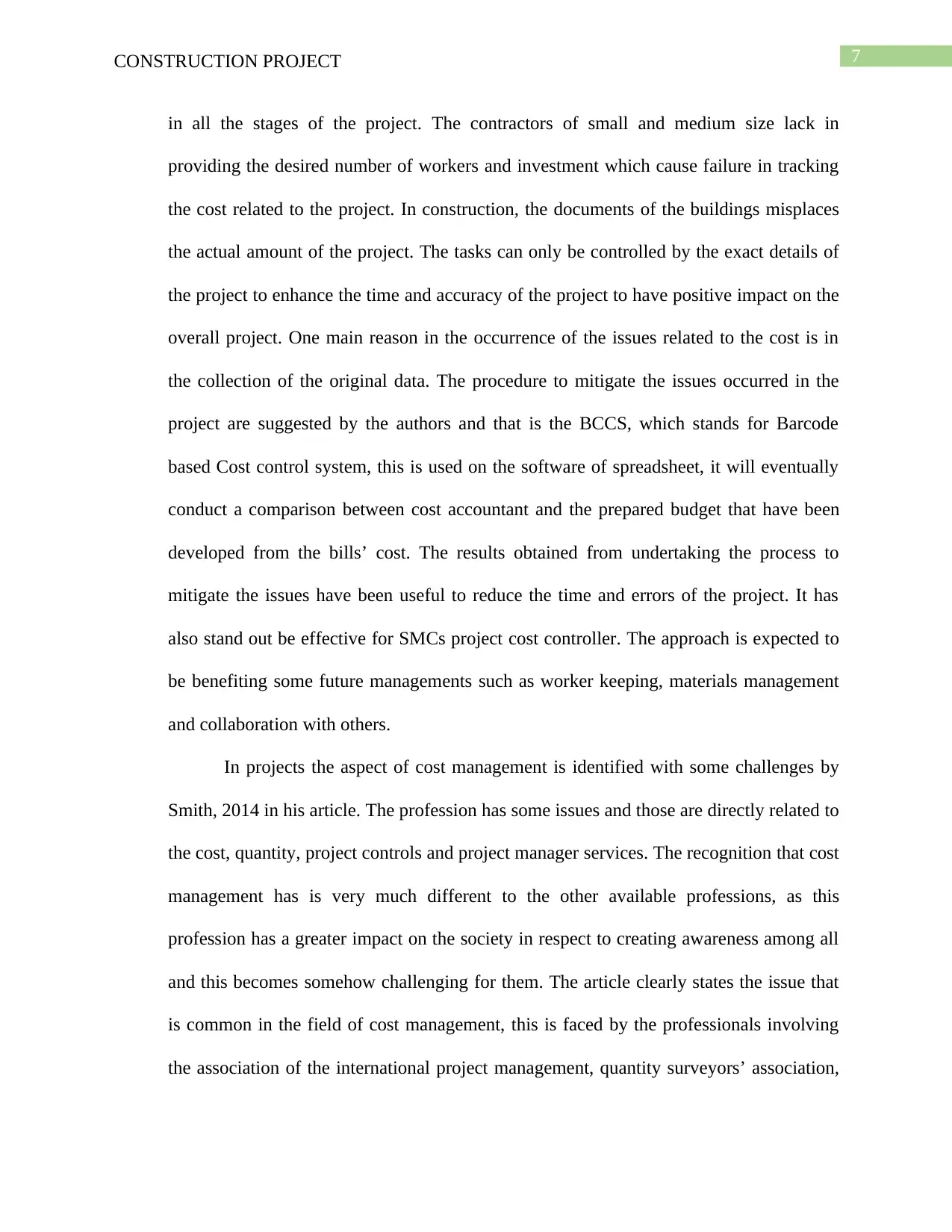
7CONSTRUCTION PROJECT
in all the stages of the project. The contractors of small and medium size lack in
providing the desired number of workers and investment which cause failure in tracking
the cost related to the project. In construction, the documents of the buildings misplaces
the actual amount of the project. The tasks can only be controlled by the exact details of
the project to enhance the time and accuracy of the project to have positive impact on the
overall project. One main reason in the occurrence of the issues related to the cost is in
the collection of the original data. The procedure to mitigate the issues occurred in the
project are suggested by the authors and that is the BCCS, which stands for Barcode
based Cost control system, this is used on the software of spreadsheet, it will eventually
conduct a comparison between cost accountant and the prepared budget that have been
developed from the bills’ cost. The results obtained from undertaking the process to
mitigate the issues have been useful to reduce the time and errors of the project. It has
also stand out be effective for SMCs project cost controller. The approach is expected to
be benefiting some future managements such as worker keeping, materials management
and collaboration with others.
In projects the aspect of cost management is identified with some challenges by
Smith, 2014 in his article. The profession has some issues and those are directly related to
the cost, quantity, project controls and project manager services. The recognition that cost
management has is very much different to the other available professions, as this
profession has a greater impact on the society in respect to creating awareness among all
and this becomes somehow challenging for them. The article clearly states the issue that
is common in the field of cost management, this is faced by the professionals involving
the association of the international project management, quantity surveyors’ association,
in all the stages of the project. The contractors of small and medium size lack in
providing the desired number of workers and investment which cause failure in tracking
the cost related to the project. In construction, the documents of the buildings misplaces
the actual amount of the project. The tasks can only be controlled by the exact details of
the project to enhance the time and accuracy of the project to have positive impact on the
overall project. One main reason in the occurrence of the issues related to the cost is in
the collection of the original data. The procedure to mitigate the issues occurred in the
project are suggested by the authors and that is the BCCS, which stands for Barcode
based Cost control system, this is used on the software of spreadsheet, it will eventually
conduct a comparison between cost accountant and the prepared budget that have been
developed from the bills’ cost. The results obtained from undertaking the process to
mitigate the issues have been useful to reduce the time and errors of the project. It has
also stand out be effective for SMCs project cost controller. The approach is expected to
be benefiting some future managements such as worker keeping, materials management
and collaboration with others.
In projects the aspect of cost management is identified with some challenges by
Smith, 2014 in his article. The profession has some issues and those are directly related to
the cost, quantity, project controls and project manager services. The recognition that cost
management has is very much different to the other available professions, as this
profession has a greater impact on the society in respect to creating awareness among all
and this becomes somehow challenging for them. The article clearly states the issue that
is common in the field of cost management, this is faced by the professionals involving
the association of the international project management, quantity surveyors’ association,
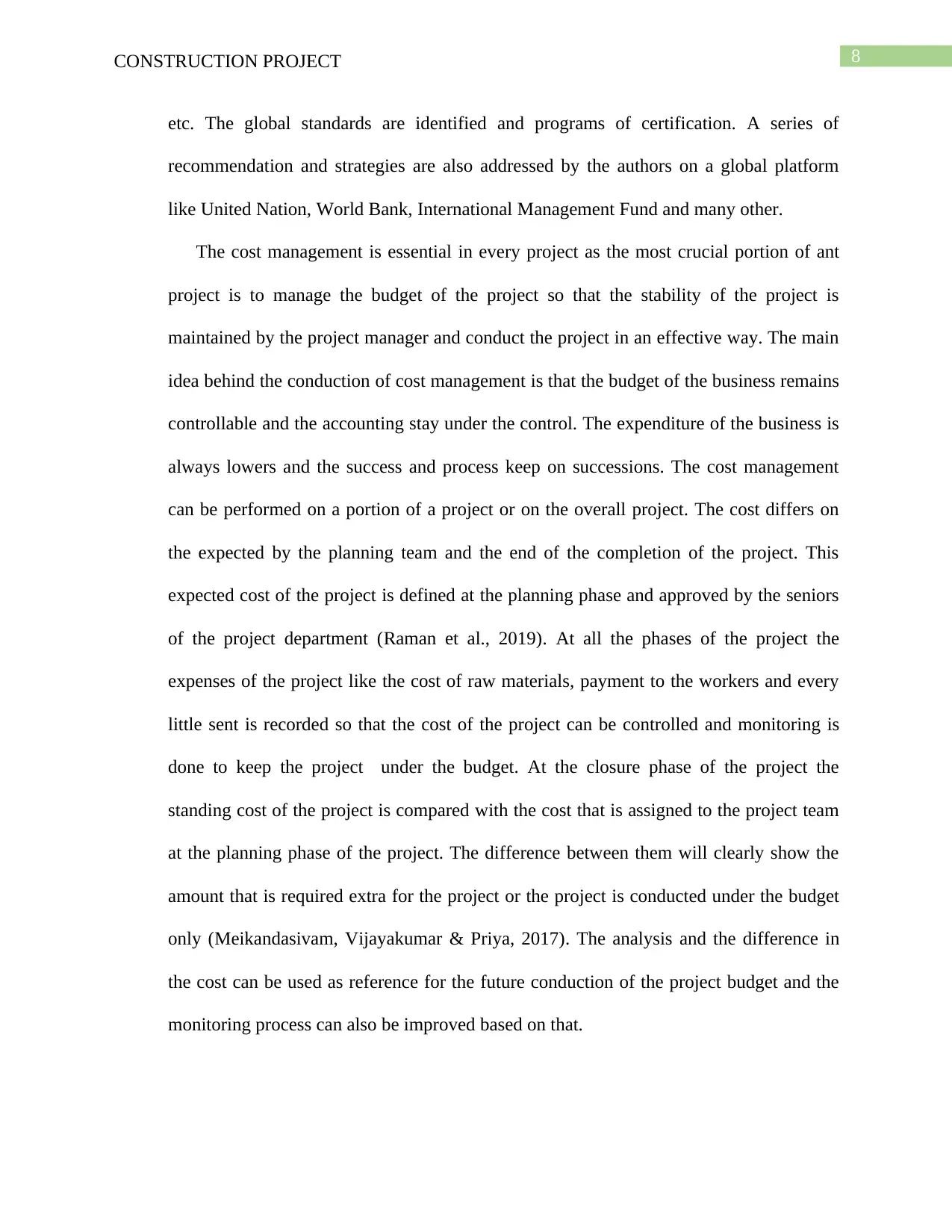
8CONSTRUCTION PROJECT
etc. The global standards are identified and programs of certification. A series of
recommendation and strategies are also addressed by the authors on a global platform
like United Nation, World Bank, International Management Fund and many other.
The cost management is essential in every project as the most crucial portion of ant
project is to manage the budget of the project so that the stability of the project is
maintained by the project manager and conduct the project in an effective way. The main
idea behind the conduction of cost management is that the budget of the business remains
controllable and the accounting stay under the control. The expenditure of the business is
always lowers and the success and process keep on successions. The cost management
can be performed on a portion of a project or on the overall project. The cost differs on
the expected by the planning team and the end of the completion of the project. This
expected cost of the project is defined at the planning phase and approved by the seniors
of the project department (Raman et al., 2019). At all the phases of the project the
expenses of the project like the cost of raw materials, payment to the workers and every
little sent is recorded so that the cost of the project can be controlled and monitoring is
done to keep the project under the budget. At the closure phase of the project the
standing cost of the project is compared with the cost that is assigned to the project team
at the planning phase of the project. The difference between them will clearly show the
amount that is required extra for the project or the project is conducted under the budget
only (Meikandasivam, Vijayakumar & Priya, 2017). The analysis and the difference in
the cost can be used as reference for the future conduction of the project budget and the
monitoring process can also be improved based on that.
etc. The global standards are identified and programs of certification. A series of
recommendation and strategies are also addressed by the authors on a global platform
like United Nation, World Bank, International Management Fund and many other.
The cost management is essential in every project as the most crucial portion of ant
project is to manage the budget of the project so that the stability of the project is
maintained by the project manager and conduct the project in an effective way. The main
idea behind the conduction of cost management is that the budget of the business remains
controllable and the accounting stay under the control. The expenditure of the business is
always lowers and the success and process keep on successions. The cost management
can be performed on a portion of a project or on the overall project. The cost differs on
the expected by the planning team and the end of the completion of the project. This
expected cost of the project is defined at the planning phase and approved by the seniors
of the project department (Raman et al., 2019). At all the phases of the project the
expenses of the project like the cost of raw materials, payment to the workers and every
little sent is recorded so that the cost of the project can be controlled and monitoring is
done to keep the project under the budget. At the closure phase of the project the
standing cost of the project is compared with the cost that is assigned to the project team
at the planning phase of the project. The difference between them will clearly show the
amount that is required extra for the project or the project is conducted under the budget
only (Meikandasivam, Vijayakumar & Priya, 2017). The analysis and the difference in
the cost can be used as reference for the future conduction of the project budget and the
monitoring process can also be improved based on that.
⊘ This is a preview!⊘
Do you want full access?
Subscribe today to unlock all pages.

Trusted by 1+ million students worldwide
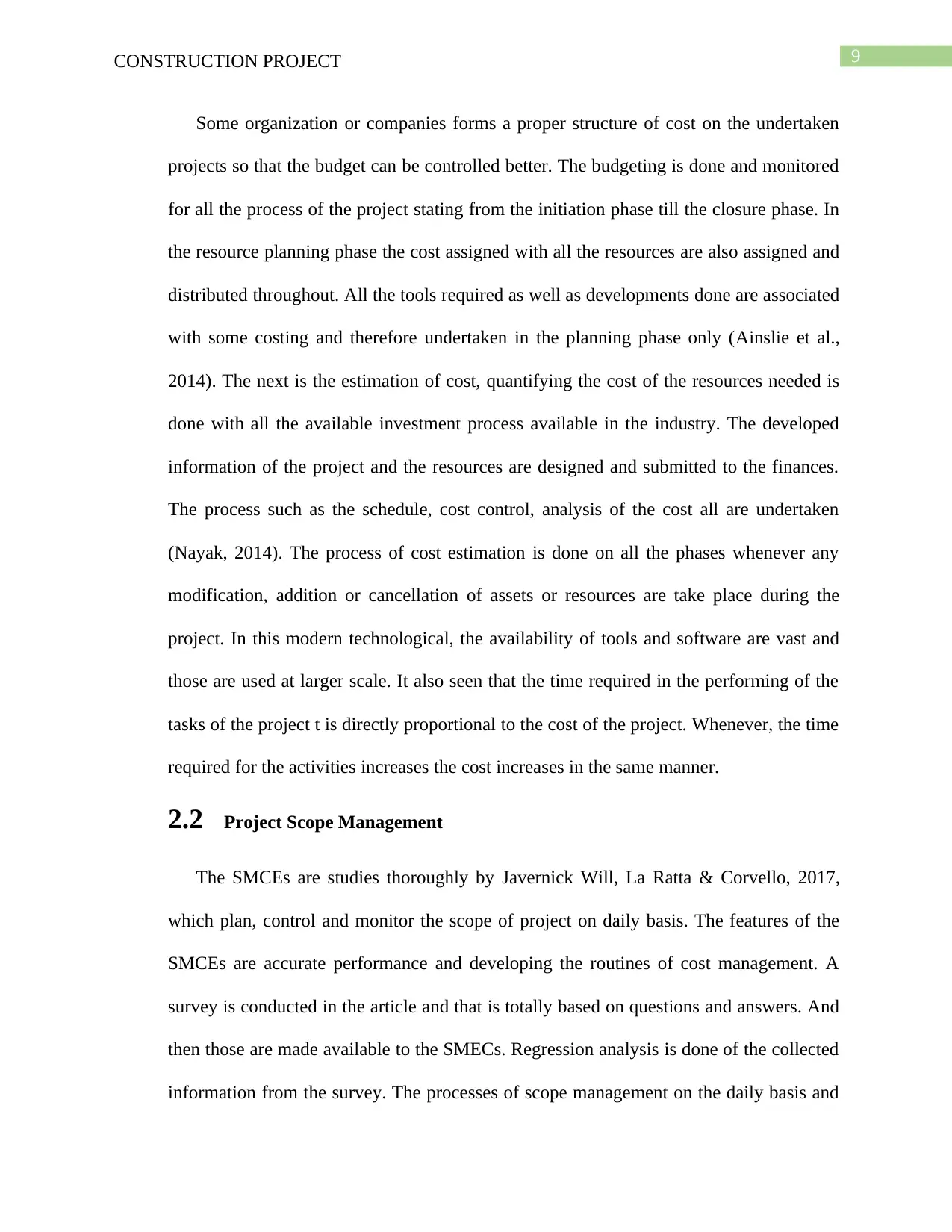
9CONSTRUCTION PROJECT
Some organization or companies forms a proper structure of cost on the undertaken
projects so that the budget can be controlled better. The budgeting is done and monitored
for all the process of the project stating from the initiation phase till the closure phase. In
the resource planning phase the cost assigned with all the resources are also assigned and
distributed throughout. All the tools required as well as developments done are associated
with some costing and therefore undertaken in the planning phase only (Ainslie et al.,
2014). The next is the estimation of cost, quantifying the cost of the resources needed is
done with all the available investment process available in the industry. The developed
information of the project and the resources are designed and submitted to the finances.
The process such as the schedule, cost control, analysis of the cost all are undertaken
(Nayak, 2014). The process of cost estimation is done on all the phases whenever any
modification, addition or cancellation of assets or resources are take place during the
project. In this modern technological, the availability of tools and software are vast and
those are used at larger scale. It also seen that the time required in the performing of the
tasks of the project t is directly proportional to the cost of the project. Whenever, the time
required for the activities increases the cost increases in the same manner.
2.2 Project Scope Management
The SMCEs are studies thoroughly by Javernick Will, La Ratta & Corvello, 2017,
which plan, control and monitor the scope of project on daily basis. The features of the
SMCEs are accurate performance and developing the routines of cost management. A
survey is conducted in the article and that is totally based on questions and answers. And
then those are made available to the SMECs. Regression analysis is done of the collected
information from the survey. The processes of scope management on the daily basis and
Some organization or companies forms a proper structure of cost on the undertaken
projects so that the budget can be controlled better. The budgeting is done and monitored
for all the process of the project stating from the initiation phase till the closure phase. In
the resource planning phase the cost assigned with all the resources are also assigned and
distributed throughout. All the tools required as well as developments done are associated
with some costing and therefore undertaken in the planning phase only (Ainslie et al.,
2014). The next is the estimation of cost, quantifying the cost of the resources needed is
done with all the available investment process available in the industry. The developed
information of the project and the resources are designed and submitted to the finances.
The process such as the schedule, cost control, analysis of the cost all are undertaken
(Nayak, 2014). The process of cost estimation is done on all the phases whenever any
modification, addition or cancellation of assets or resources are take place during the
project. In this modern technological, the availability of tools and software are vast and
those are used at larger scale. It also seen that the time required in the performing of the
tasks of the project t is directly proportional to the cost of the project. Whenever, the time
required for the activities increases the cost increases in the same manner.
2.2 Project Scope Management
The SMCEs are studies thoroughly by Javernick Will, La Ratta & Corvello, 2017,
which plan, control and monitor the scope of project on daily basis. The features of the
SMCEs are accurate performance and developing the routines of cost management. A
survey is conducted in the article and that is totally based on questions and answers. And
then those are made available to the SMECs. Regression analysis is done of the collected
information from the survey. The processes of scope management on the daily basis and
Paraphrase This Document
Need a fresh take? Get an instant paraphrase of this document with our AI Paraphraser
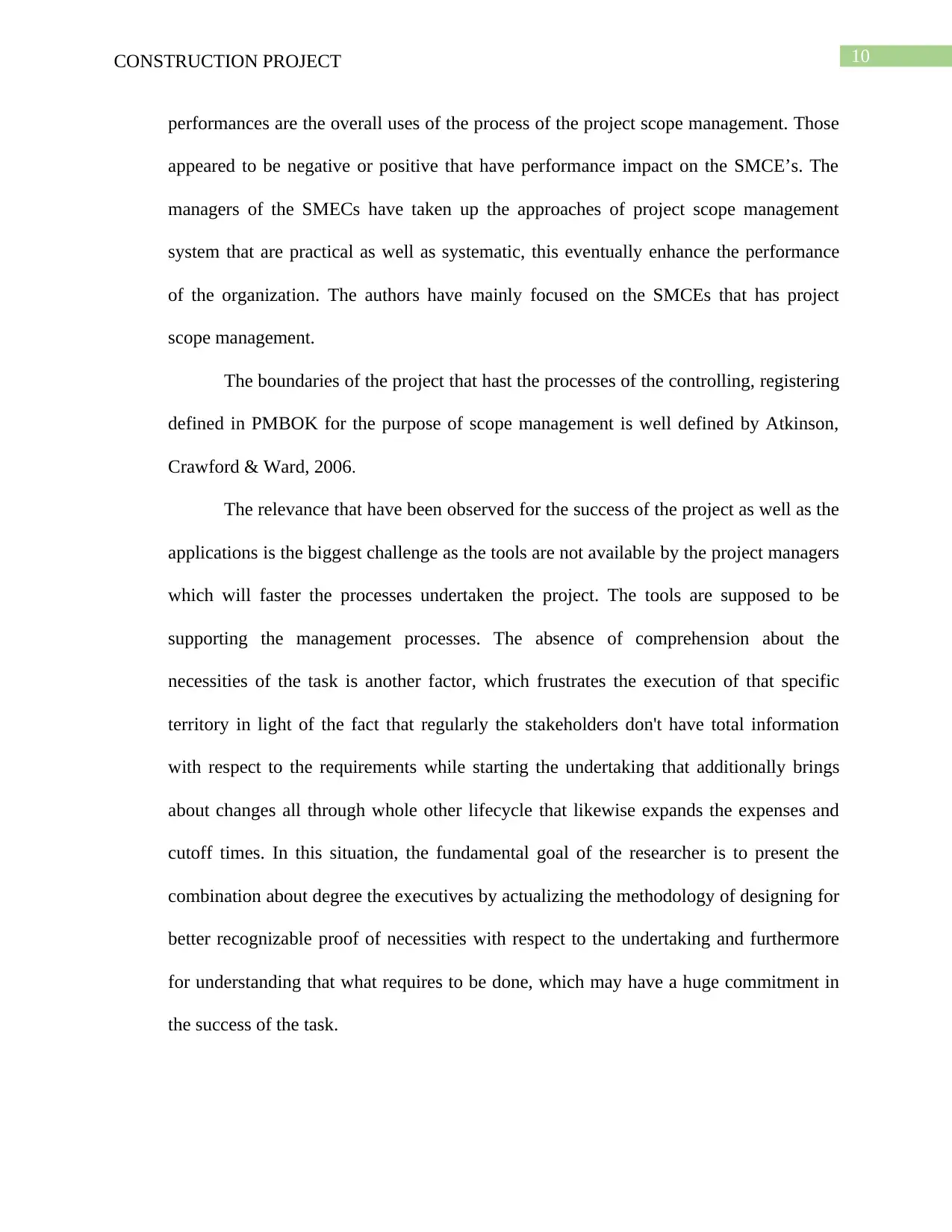
10CONSTRUCTION PROJECT
performances are the overall uses of the process of the project scope management. Those
appeared to be negative or positive that have performance impact on the SMCE’s. The
managers of the SMECs have taken up the approaches of project scope management
system that are practical as well as systematic, this eventually enhance the performance
of the organization. The authors have mainly focused on the SMCEs that has project
scope management.
The boundaries of the project that hast the processes of the controlling, registering
defined in PMBOK for the purpose of scope management is well defined by Atkinson,
Crawford & Ward, 2006.
The relevance that have been observed for the success of the project as well as the
applications is the biggest challenge as the tools are not available by the project managers
which will faster the processes undertaken the project. The tools are supposed to be
supporting the management processes. The absence of comprehension about the
necessities of the task is another factor, which frustrates the execution of that specific
territory in light of the fact that regularly the stakeholders don't have total information
with respect to the requirements while starting the undertaking that additionally brings
about changes all through whole other lifecycle that likewise expands the expenses and
cutoff times. In this situation, the fundamental goal of the researcher is to present the
combination about degree the executives by actualizing the methodology of designing for
better recognizable proof of necessities with respect to the undertaking and furthermore
for understanding that what requires to be done, which may have a huge commitment in
the success of the task.
performances are the overall uses of the process of the project scope management. Those
appeared to be negative or positive that have performance impact on the SMCE’s. The
managers of the SMECs have taken up the approaches of project scope management
system that are practical as well as systematic, this eventually enhance the performance
of the organization. The authors have mainly focused on the SMCEs that has project
scope management.
The boundaries of the project that hast the processes of the controlling, registering
defined in PMBOK for the purpose of scope management is well defined by Atkinson,
Crawford & Ward, 2006.
The relevance that have been observed for the success of the project as well as the
applications is the biggest challenge as the tools are not available by the project managers
which will faster the processes undertaken the project. The tools are supposed to be
supporting the management processes. The absence of comprehension about the
necessities of the task is another factor, which frustrates the execution of that specific
territory in light of the fact that regularly the stakeholders don't have total information
with respect to the requirements while starting the undertaking that additionally brings
about changes all through whole other lifecycle that likewise expands the expenses and
cutoff times. In this situation, the fundamental goal of the researcher is to present the
combination about degree the executives by actualizing the methodology of designing for
better recognizable proof of necessities with respect to the undertaking and furthermore
for understanding that what requires to be done, which may have a huge commitment in
the success of the task.
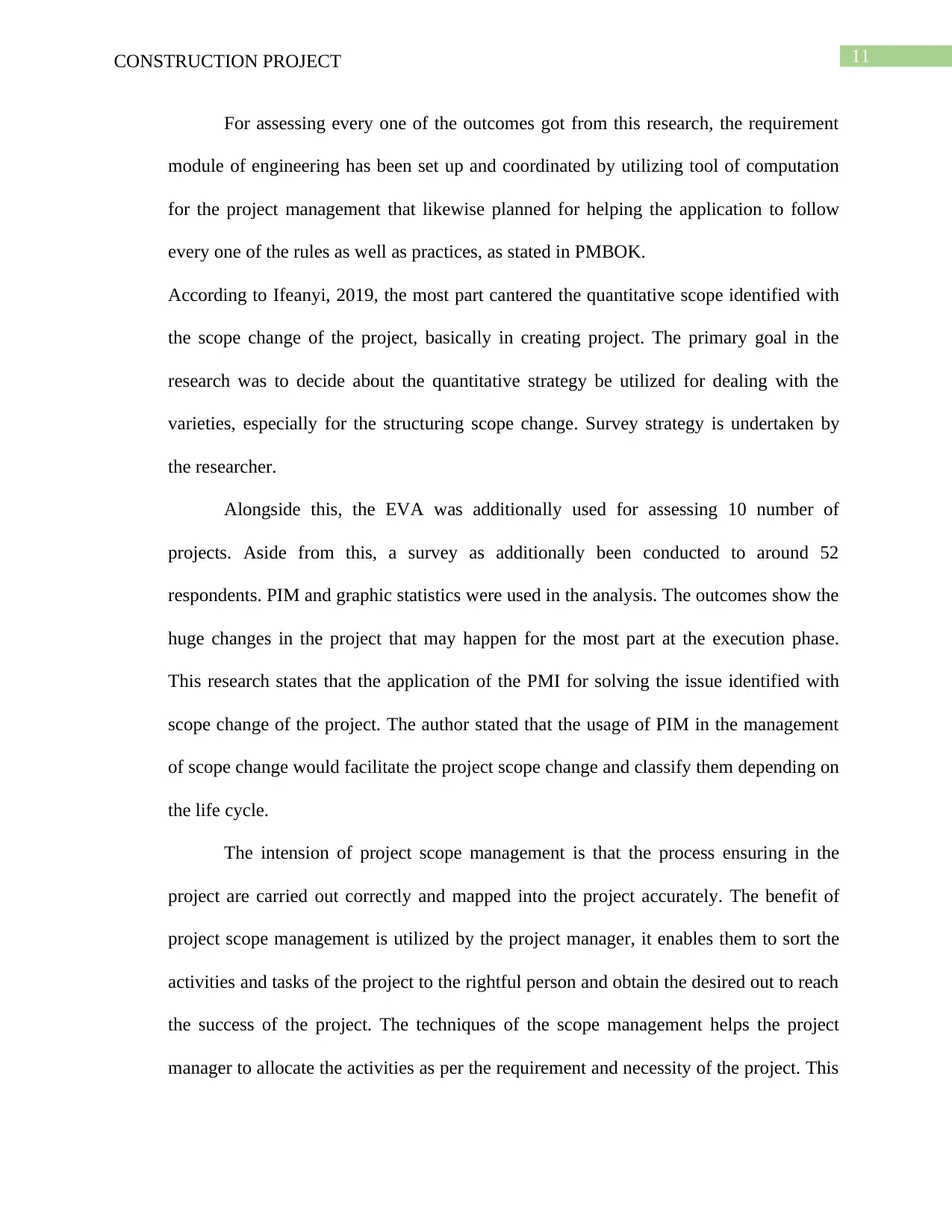
11CONSTRUCTION PROJECT
For assessing every one of the outcomes got from this research, the requirement
module of engineering has been set up and coordinated by utilizing tool of computation
for the project management that likewise planned for helping the application to follow
every one of the rules as well as practices, as stated in PMBOK.
According to Ifeanyi, 2019, the most part cantered the quantitative scope identified with
the scope change of the project, basically in creating project. The primary goal in the
research was to decide about the quantitative strategy be utilized for dealing with the
varieties, especially for the structuring scope change. Survey strategy is undertaken by
the researcher.
Alongside this, the EVA was additionally used for assessing 10 number of
projects. Aside from this, a survey as additionally been conducted to around 52
respondents. PIM and graphic statistics were used in the analysis. The outcomes show the
huge changes in the project that may happen for the most part at the execution phase.
This research states that the application of the PMI for solving the issue identified with
scope change of the project. The author stated that the usage of PIM in the management
of scope change would facilitate the project scope change and classify them depending on
the life cycle.
The intension of project scope management is that the process ensuring in the
project are carried out correctly and mapped into the project accurately. The benefit of
project scope management is utilized by the project manager, it enables them to sort the
activities and tasks of the project to the rightful person and obtain the desired out to reach
the success of the project. The techniques of the scope management helps the project
manager to allocate the activities as per the requirement and necessity of the project. This
For assessing every one of the outcomes got from this research, the requirement
module of engineering has been set up and coordinated by utilizing tool of computation
for the project management that likewise planned for helping the application to follow
every one of the rules as well as practices, as stated in PMBOK.
According to Ifeanyi, 2019, the most part cantered the quantitative scope identified with
the scope change of the project, basically in creating project. The primary goal in the
research was to decide about the quantitative strategy be utilized for dealing with the
varieties, especially for the structuring scope change. Survey strategy is undertaken by
the researcher.
Alongside this, the EVA was additionally used for assessing 10 number of
projects. Aside from this, a survey as additionally been conducted to around 52
respondents. PIM and graphic statistics were used in the analysis. The outcomes show the
huge changes in the project that may happen for the most part at the execution phase.
This research states that the application of the PMI for solving the issue identified with
scope change of the project. The author stated that the usage of PIM in the management
of scope change would facilitate the project scope change and classify them depending on
the life cycle.
The intension of project scope management is that the process ensuring in the
project are carried out correctly and mapped into the project accurately. The benefit of
project scope management is utilized by the project manager, it enables them to sort the
activities and tasks of the project to the rightful person and obtain the desired out to reach
the success of the project. The techniques of the scope management helps the project
manager to allocate the activities as per the requirement and necessity of the project. This
⊘ This is a preview!⊘
Do you want full access?
Subscribe today to unlock all pages.

Trusted by 1+ million students worldwide
1 out of 43
Related Documents
Your All-in-One AI-Powered Toolkit for Academic Success.
+13062052269
info@desklib.com
Available 24*7 on WhatsApp / Email
![[object Object]](/_next/static/media/star-bottom.7253800d.svg)
Unlock your academic potential
Copyright © 2020–2025 A2Z Services. All Rights Reserved. Developed and managed by ZUCOL.





